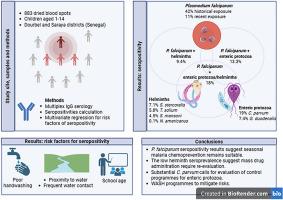Serological assessment of pediatric parasite exposure in two Senegalese districts using multiplex serology
IF 1.7
Q3 PARASITOLOGY
Current research in parasitology & vector-borne diseases
Pub Date : 2025-01-01
DOI:10.1016/j.crpvbd.2025.100320
引用次数: 0
Abstract
Although pediatric parasitic diseases cause significant morbidity and mortality in regions with high rates of co-infection, this overlap may offer opportunities for integrated control strategies. This study aimed at a serological assessment of exposure to multiple parasitic infections among children aged 1–14 years in two Senegalese districts, Saraya (Kédougou Region) and Diourbel (Diourbel Region), to inform integrated control strategies. We analysed 883 dried blood spot samples. A multiplex bead-based immunoassay quantified IgG antibody against Plasmodium falciparum, helminths (Necator americanus, Schistosoma mansoni, Strongyloides stercoralis, Taenia solium), and intestinal protozoa (Cryptosporidium parvum, Giardia duodenalis) as proxies for single- and multiple-pathogen exposure. Multivariable logistic regression identified risk factors for seropositivity. Recent malaria exposure was identified in 11% of children, while 42% showed evidence of historical exposure. Helminth seroprevalence ranged between 0.1% and 7.2%, whereas Cryptosporidium parvum and Giardia duodenalis seroprevalence values were 19.0% and 7.4%, respectively. Co-exposures to malaria and other parasites ranged from 9.4% to 18.0%. School-aged children exhibited higher seroprevalence rates for historical exposure to P. falciparum and S. stercoralis compared to pre-school children, while G. duodenalis was more seroprevalent in pre-school children. Saraya exhibited higher seroprevalence for historical P. falciparum and G. duodenalis exposure. Rare/never handwashing before meals, shorter travel time to a water source (< 10 min, likely reflecting residence near shared or surface water rather than improved household taps), and frequent contact with any waterbodies (daily/weekly) were associated with higher odds of parasite seropositivity. While seasonal malaria chemoprevention appears suitable, the low helminth seroprevalence coupled with substantial protozoan exposure suggests that current integrated interventions may require re-evaluation and enhancement.

使用多重血清学对塞内加尔两个地区儿童寄生虫暴露进行血清学评估
虽然儿童寄生虫病在合并感染率高的区域造成很高的发病率和死亡率,但这种重叠可能为综合控制战略提供机会。这项研究的目的是对塞内加尔Saraya (ksamadougou区)和Diourbel (Diourbel区)两个区1-14岁儿童的多种寄生虫感染暴露情况进行血清学评估,以便为综合控制战略提供信息。我们分析了883份干血斑样本。一种基于多重球的免疫测定定量了针对恶性疟原虫、蠕虫(美洲血吸虫、曼氏血吸虫、粪类圆线虫、猪带绦虫)和肠道原生动物(小隐孢子虫、十二指肠贾第鞭毛虫)的IgG抗体,作为单一和多种病原体暴露的替代指标。多变量逻辑回归确定了血清阳性的危险因素。11%的儿童最近接触过疟疾,42%的儿童有接触史。寄生虫血清阳性率为0.1% ~ 7.2%,小隐孢子虫和十二指肠贾第鞭毛虫血清阳性率分别为19.0%和7.4%。疟疾和其他寄生虫的共同暴露率为9.4%至18.0%。与学龄前儿童相比,学龄儿童暴露于恶性疟原虫和粪链球菌的血清阳性率更高,而十二指肠链球菌的血清阳性率在学龄前儿童中更高。萨拉亚表现出较高的血清恶性疟原虫和十二指肠棘球蚴暴露率。饭前很少或从不洗手,到水源的旅行时间较短(10分钟,可能反映居住在公用或地表水附近,而不是改善的家庭水龙头),以及频繁接触任何水体(每天/每周)与寄生虫血清阳性的可能性较高相关。虽然季节性疟疾化学预防似乎是合适的,但低寄生虫血清阳性率加上大量原生动物暴露表明,目前的综合干预措施可能需要重新评估和加强。
本文章由计算机程序翻译,如有差异,请以英文原文为准。
求助全文
约1分钟内获得全文
求助全文

 求助内容:
求助内容: 应助结果提醒方式:
应助结果提醒方式:


